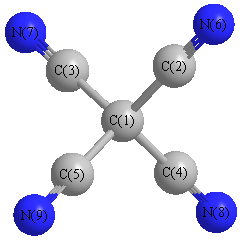Vibrational Frequencies calculated at QCISD/TZVP
| Mode Number |
Symmetry |
Frequency
(cm-1) |
Scaled Frequency
(cm-1) |
IR Intensities
(km mol-1) |
Raman Act
(Å4/u) |
Dep P |
Dep U |
|---|
| 1 |
A1 |
2363 |
2258 |
0.00 |
|
|
|
| 2 |
A1 |
589 |
563 |
0.00 |
|
|
|
| 3 |
E |
566 |
541 |
0.00 |
|
|
|
| 3 |
E |
566 |
541 |
0.00 |
|
|
|
| 4 |
E |
112 |
107 |
0.00 |
|
|
|
| 4 |
E |
112 |
107 |
0.00 |
|
|
|
| 5 |
T1 |
329 |
314 |
0.00 |
|
|
|
| 5 |
T1 |
329 |
314 |
0.00 |
|
|
|
| 5 |
T1 |
329 |
314 |
0.00 |
|
|
|
| 6 |
T2 |
2359 |
2254 |
12.22 |
|
|
|
| 6 |
T2 |
2359 |
2254 |
12.22 |
|
|
|
| 6 |
T2 |
2359 |
2254 |
12.22 |
|
|
|
| 7 |
T2 |
1106 |
1057 |
34.82 |
|
|
|
| 7 |
T2 |
1106 |
1057 |
34.82 |
|
|
|
| 7 |
T2 |
1106 |
1057 |
34.82 |
|
|
|
| 8 |
T2 |
561 |
536 |
0.01 |
|
|
|
| 8 |
T2 |
561 |
536 |
0.01 |
|
|
|
| 8 |
T2 |
561 |
536 |
0.01 |
|
|
|
| 9 |
T2 |
146 |
139 |
13.18 |
|
|
|
| 9 |
T2 |
146 |
139 |
13.18 |
|
|
|
| 9 |
T2 |
146 |
139 |
13.18 |
|
|
|
Unscaled Zero Point Vibrational Energy (zpe) 8905.9 cm
-1
Scaled (by 0.9553) Zero Point Vibrational Energy (zpe) 8507.8 cm
-1
See section
III.C.1 List or set vibrational scaling factors
to change the scale factors used here.
See section
III.C.2
Calculate a vibrational scaling factor for a given set of molecules
to determine the least squares best scaling factor.
